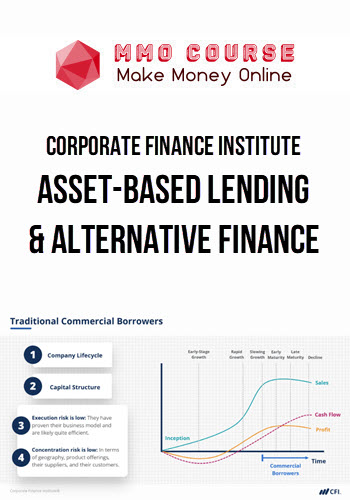Corporate Finance Institute – Asset-Based Lending & Alternative Finance
$997.00 $27.00
Delivery: Instant Delivery
Description
Corporate Finance Institute – Asset-Based Lending & Alternative Finance
Examine lending structures for borrowers that may not fit the parameters of a traditional senior lender (like a commercial bank or credit union)
- Explore non-traditional lending solutions like PO financing, factoring, and ABL
- Understand how these loan types are structured and analyzed
- Work through client examples and examine a projection model
This Asset-Based Lending & Alternative Finance course dives into lending solutions for borrowers that don’t fit the target profile of a more traditional senior lender, like a commercial bank. Despite falling short of these requirements, many companies are still attractive borrowing prospects for alternative finance firms. This course shows how lenders assess these unique opportunities and structure non-standard credit by leveraging balance sheet assets as collateral to support riskier borrowers. We will also examine the differences between these solutions and more traditional forms of commercial financing.
The lending solutions we will be looking at in this course are: purchase order financing (PO financing), accounts receivable factoring (A/R factoring), asset-based lending lines (ABL lines), and sale-and-leasebacks.
This Asset-Based Lending & Alternative Finance course is suited for current and aspiring commercial lending professionals and credit analysts. Commercial bankers and analysts can work for many different types of financial institutions. It is important to understand the tools available for any type of lender to provide value to their borrowers. This course will prepare you with the knowledge you need to identify and apply these alternative financing tools and strategies.
What You’ll Learn In Asset-Based Lending & Alternative Finance?
- Compare alternative lending structures, including purchase order financing, accounts receivable factoring, Asset-based lending (ABL) lines, and sale-and-leaseback transactions.
- Differentiate between asset-based lending solutions and more traditional forms of commercial financing—like operating lines of credit.
- Analyze the underlying causes of weak or deteriorating risk ratings and identify when a good lending opportunity may still exist.
- Calculate credit needs for various borrowing scenarios.
- Recommend the most appropriate lending solution based on important client characteristics like business type, lifecycle, and capital structure.
Sale Page: Corporate Finance Institute – Asset-Based Lending & Alternative Finance
Delivery Policy
When will I receive my course?
You will receive a link to download your course immediately or within 1 to 21 days. It depends on the product you buy, so please read the short description of the product carefully before making a purchase.
How is my course delivered?
We share courses through Google Drive, so once your order is complete, you'll receive an invitation to view the course in your email.
To avoid any delay in delivery, please provide a Google mail and enter your email address correctly in the Checkout Page.
In case you submit a wrong email address, please contact us to resend the course to the correct email.
How do I check status of my order?
Please log in to MMOCourse account then go to Order Page. You will find all your orders includes number, date, status and total price.
If the status is Processing: Your course is being uploaded. Please be patient and wait for us to complete your order. If your order has multiple courses and one of them has not been updated with the download link, the status of the order is also Processing.
If the status is Completed: Your course is ready for immediate download. Click "VIEW" to view details and download the course.
Where can I find my course?
Once your order is complete, a link to download the course will automatically be sent to your email.
You can also get the download link by logging into your mmocourse.hk account then going to Downloads Page.
Related products
Total sold: 3










